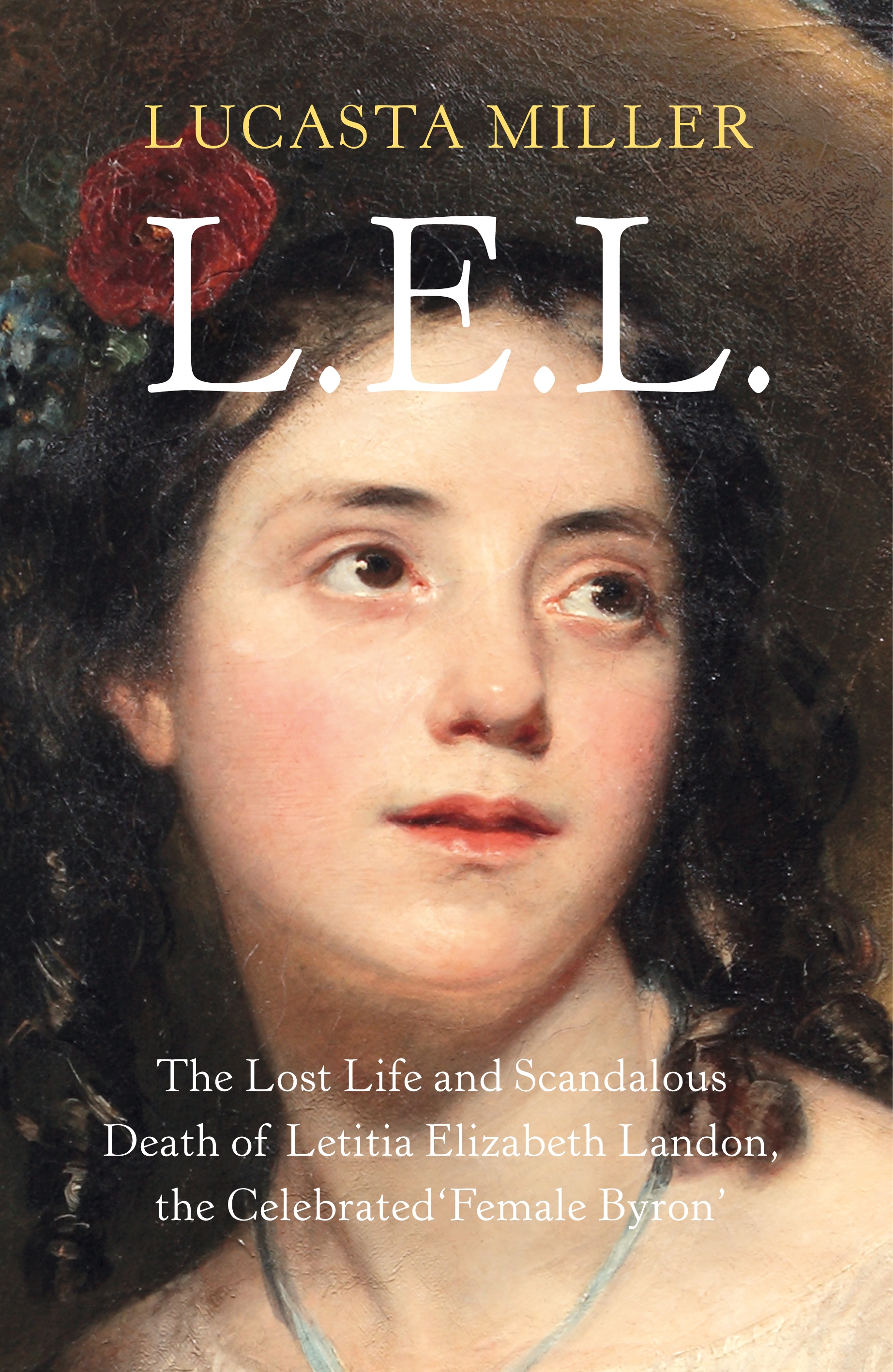I was expecting a specific kind of story from Lucasta Miller’s new biography L.E.L: The Lost Life and Scandalous Death of Letitia Elizabeth Landon, the Celebrated ‘Female Byron.’ I assumed it would be a natural fit for Women’s History Month: Sexist double standards sideline Romantic poet! I thought I would be reading about a feminist foremother; instead, I got the story of a woman fed into a meat grinder.
A prolific writer of prose and poetry, Landon was famous in her day, highly regarded by luminaries including Edgar Allan Poe and Elizabeth Barrett Browning. But her reputation plummeted following revelations of an affair with her editor, William Jerdan. Her sensuous verses—the “passionate songs of beating hearts,” as she put it—were ill-matched to the mores of the Victorian era that began (technically) the year before her death. Early 20th-century critics, Miller writes, dismissed Landon “as a saccharine lady sentimentalist.” Despite the efforts of feminist critics from the 1970s onward, she’s virtually unknown outside academia today.
Landon’s life is worth revisiting now precisely because it can’t be made into a neat feminist hagiography. Like many women, Landon contorted her words and public image to fit a model of acceptable femininity while pursuing an ambitious career. She didn’t launch an attack on sexist institutions. She only tried to evade their punishments. And like many of us, Landon failed. She died at age 36, just two months into an unhappy marriage that was prompted by her fall from grace in London’s literary circles. She had overdosed, perhaps purposefully, on prussic acid, to which Miller argues she was addicted.
In 2019, you can tailor your media diet so you’re fed a continuous celebration of women who are kicking butt, defying the odds, and breaking down barriers in their fields. “Failing” at feminism can come to feel like your own fault, rather than the default outcome of entrenched sexism. Landon’s story is a reminder of just how hard it is to be a woman in a world of rampant power imbalances—like the world we still live in.

Landon has been labeled “the female Byron” and “the Sappho of a polished age.” To my mind, though, the public figure she most closely resembles is Britney Spears. The two had the same gimmick: Entice your audience by straddling the line between virgin and whore.

(Photo: Penguin Random House)
When Landon began publishing poetry, she wrote under the initials “L.E.L.” Rumors buzzed about her identity: Was she, her contemporaries asked, “a Girl / Just blushing into woman,” or a fallen woman, “wrecked by love’s treachery”? She had presented herself as both in a poem that appeared in the Literary Gazette in the early 1820s. L.E.L. stoked her readers’ fascination through “buried allusions, half-quotations, and hinted insinuations,” Miller writes. Consider this “love spell,” written in the voice of a “simple young girl” who hangs a wreath of white roses—supposedly a symbol of sexual purity—above her bed.
The roses are linked
In a chain pure and white
And the rose-leaves are wet
With the dew drops of night.
(Then consider what it means for a girl’s rose-leaves to be wet at night.)
Inhabiting the space between innocent and vamp allowed Landon, like Britney, to talk openly about sex while pretending she wasn’t having any. It gave each of them some protection in a world where sexual missteps could cost a woman her career.
Part of what made Britney irresistible, as Chuck Klosterman wrote in a 2003 Esquire article, was her public invitation to project onto her your own vision of who she was. Similarly, Landon’s “‘I’ was elastic, an empty space to be filled,” Miller writes. Landon allowed people to see what they wanted when they looked at her; the technique served as a defense mechanism by which she preserved something of herself as she became more famous and increasingly subject to scrutiny. As Spears shows us, sexual ambiguity remains useful to women who need to please male audiences—and male gatekeepers—for their careers to flourish.
But these stratagems offered Landon protection for only so long. Eventually, it would come out that Landon (like Britney) was no virgin—and when it did, audiences were waiting to tear her down. Landon’s affair with Jerdan stretched over 15 years. She bore three of his children, and he helped fuel his protégée’s rise to fame. A “satyr cannibal Literary Gazetteer,” in Thomas Carlyle’s words, Jerdan’s taste for very young women was considered exceptional even in his own day.
“He was a middle-aged man with the patriarchal power of patronage,” Miller writes. When their affair began, “she was a teenager desperate for affirmation”—and for money. A literary career was one of the few available to Landon after her father went bankrupt and abandoned their family. (Though she didn’t earn much money from Jerdan, who didn’t compensate her for her contributions and what Miller characterizes as her “effective co-editorship” of his Literary Gazette, and who appropriated large portions of her book advances to pay off his debts.)
The same collective zeal that went into building Landon’s fame was soon applied to destroying it. After the Sunday Times exposed their affair, Landon was mocked in public—and in biting satirical publications like Fraser’s. Her social circle shrank to a few loyal friends. Jerdan, of course, escaped unscathed, taking up with another young mistress.
Landon’s relationship with Jerdan rests somewhere in that vast distance between enthusiastic consent and violent coercion that many of us are still learning to talk about. It was consensual, and the two seemed to have enjoyed a level of romantic, even domestic, attachment. But it wasn’t freely chosen, given the significant gap in age and status between them: “Letitia’s situation meant that she was little able to detach herself from the economic and power nexus Jerdan represented,” Miller writes.
Landon was damned by the misogynistic double standards of literary London and paid a far higher price for the affair than Jerdan did. She was damned, too, by larger cultural changes: By the time of her death in 1838, English culture was shifting away from “demi-connaissance, or half-knowledge, through which high society tacitly permitted illicit sexual relationships,” toward the “full-blown denial of Victorian bourgeois hypocrisy,” Miller writes. Landon’s sensual verses, inspired by the late Romantics—Shelley, Keats, and Byron, whom the conservative poet Robert Southey dubbed the “Satanic School”—fell out of fashion. The “new image for a celebrity writer,” Miller argues, was embodied by Dickens, who promulgated “‘Victorian’ family values” in his bestsellers.

(Photo: Sim Canetty-Clarke)
“This book is about a poet who disappeared,” Miller writes in the book’s preface. That inactive verb is perhaps misleading: Landon was actively disappeared by memoirists who would rather, in the words of her first biographer, Edward Bulwer-Lytton, “keep her name as a pleasant odor in the world” than admit the more unsavory truths of her life. And she was further disappeared beneath the many fictional versions of her life that cropped up in novels by Bulwer-Lytton, G.H. Lewes, and others: In some, she was described as “the embodiment of unsullied purity”; in others, she’s turned into a Piccadilly Circus streetwalker.
Reading Landon’s story, I felt the temptation to continue to fictionalize the tale by massaging it into something more palatably feminist. But Miller makes it clear that Landon herself was no feminist. She lived in an era when “the public discourse of feminism, once spearheaded by Mary Wollstonecraft, contracted to the point of nullity.” After a brief embrace of radical politics in her teens, Landon’s cynicism and “mirroring tendencies,” as she wrote in a letter to a friend, kicked in, and she reflected back her culture’s distaste for emancipated women.
Even in her own day, Landon was criticized for the misogynistic content of her verses. “She takes every opportunity of preaching up this perfect subordination, and of bestowing admiration on the qualities which fit women for being useful and agreeable slaves,” an anonymous reviewer wrote in the Westminster Review in 1827. (Miller speculates that the reviewer was John Stuart Mill, author of The Subjection of Women.)
The bizarre final chapter of Landon’s life makes it even more difficult to see her as any kind of feminist hero. By the time of her death in 1838, slavery had officially been abolished for more than 30 years, but the British trade network in Africa was still deeply dependent on slave labor and trade with slavers. Her husband, George Maclean, avoided cracking down on merchants who profited from slavery, and is alleged to have owned slaves himself.
Through marriage, Landon entered into a degree of complicity in the slave economy of her new home. She defended her husband’s undeserved reputation as an abolitionist. The floors in the garrison where she spent her final days were scrubbed by “prisoners” kept in the dungeons that had held slaves, supervised by guards with bayonets—a fact she never mentions in her letters home. Even before her marriage, she painted mawkish portraits of slavery in poems like “The African” that show “an African prince,” as Miller writes, “sold into slavery [who] finds a new and better ‘home’ in his conversation to Christianity by a sexless, blue-eyed female child.”
Miller’s biography is the first to grapple with Landon’s story in all its complexity. Landon comes most fully to life when we refrain from projecting our own politics onto her image. Like all feminist literature worthy of the name, Miller’s biography begins with the premise that women are complex and human—and that it’s worth examining their stories, even or especially when they don’t comport with our expectations for feminist success.

Pacific Standard’s Ideas section is your destination for idea-driven features, voracious culture coverage, sharp opinion, and enlightening conversation. Help us shape our ongoing coverage by responding to a short reader survey.



!["Because our [Arab and Muslim] stories aren't told in mainstream media, it's up to us now to control that narrative. ... And until there's equal representation, I'm going to talk about Arab representation and diversity."](https://psmag.com/wp-content/uploads/2024/07/wafia_esperopsmag.jpg?w=380&h=250&crop=1)

